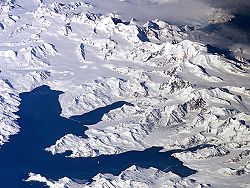Cumberland Bay

Cumberland Bay is a bay on the northern coast of South Georgia. It is 4 miles wide at its entrance between Larsen Point and Barff Point, and it separates into two extensive arms that recede inland 9 miles. The bay was discovered and named in 1775 by a British expedition under James Cook.
The Thatcher Peninsula divides the Cumberland Bay into two extensive bays: Cumberland West Bay and Cumberland East Bay.
Cumberland East Bay

Cumberland East Bay is a forms the eastern arm of Cumberland Bay. It is entered between Sappho Point and Barff Point, where it is nearly 3 miles wide, and extends 8 miles in a south-easterly direction.
On 22 April – 24 April, 1982, during the Falklands War, the Special Boat Service attempted to cross Cumberland East Bay. They had landed in Hound Bay, and traversed the Sörling Valley, but were prevented from attacking Argentine positions by incessant ice and snow.[1]
Cumberland West Bay
Cumberland West Bay is a bay forming the western arm of Cumberland Bay, South Georgia. It is entered southward of Larsen Point, where it is 2.5 miles wide, and extends 7 miles in a southwest direction.
Names
Cumberland Bay was named in 1775 by Captain James Cook.
The two constituent bays were surveyed by the Swedish Antarctic Expedition, 1901–04, who named them respectively "South Bay" and "West Bay". Cumberland Bay was remapped during 1926–29 by Discovery Investigations personnel and the bays named "East Cumberland Bay" and "West Cumberland Bay". The shortened forms "East Bay" and "West Bay" were simultaneously used.
Following the South Georgia Survey, 1951–52, the UK Antarctic Place-Names Committee proposed that the names be altered to Cumberland East Bay and Cumberland West Bay and that all other names be rejected.
History
During the Second World War the whaling stations were closed except Grytviken and Leith Harbour. Most of the British and Norwegian whaling factories and catchers were destroyed by German raiders, while the rest were called up to serve under Allied command. The resident British Magistrates (W. Barlas and A.I. Fleuret) attended to the island’s defence throughout the War. The Royal Navy armed the merchant vessel Queen of Bermuda to patrol South Georgian and Antarctic waters, and deployed two four-inch guns at key locations protecting the approaches to Cumberland Bay and Stromness Bay, protecting Grytviken and Leith Harbour respectively. These batteries (still present) were manned by volunteers from among the Norwegian whalers who were trained for the purpose.
References
- ↑ Bicheno, Hugh (2006) Razor's Edge: The Unofficial History of the Falklands War. London. Weidenfield & Nicholson. ISBN 978-0-7538-2186-2
- Stonehouse, B (ed.) Encyclopedia of Antarctica and the Southern Oceans (2002, ISBN 0-471-98665-8)
- Gazetteer and Map of the BAT and SGSSI: Cumberland Bay